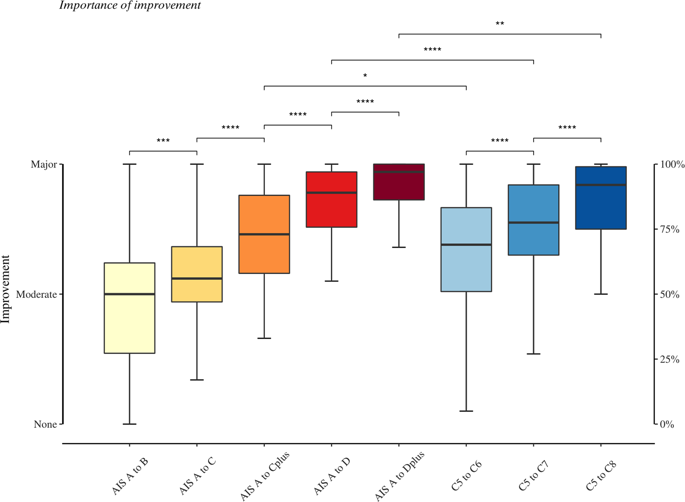当前位置:
X-MOL 学术
›
Spinal Cord
›
论文详情
Our official English website, www.x-mol.net, welcomes your
feedback! (Note: you will need to create a separate account there.)
Neurological recovery after traumatic spinal cord injury: what is meaningful? A patients' and physicians' perspective.
Spinal Cord ( IF 2.1 ) Pub Date : 2020-02-17 , DOI: 10.1038/s41393-020-0436-4 Paula Valerie Ter Wengel 1, 2, 3 , Marcel W M Post 4, 5 , Enrico Martin 6 , Janneke Stolwijk-Swuste 4 , Allard Jan Frederik Hosman 7 , Said Sadiqi 8 , William Peter Vandertop 3 , Fetullah Cumhur Öner 8
Spinal Cord ( IF 2.1 ) Pub Date : 2020-02-17 , DOI: 10.1038/s41393-020-0436-4 Paula Valerie Ter Wengel 1, 2, 3 , Marcel W M Post 4, 5 , Enrico Martin 6 , Janneke Stolwijk-Swuste 4 , Allard Jan Frederik Hosman 7 , Said Sadiqi 8 , William Peter Vandertop 3 , Fetullah Cumhur Öner 8
Affiliation

|
STUDY DESIGN
Cross-sectional survey.
OBJECTIVES
Most studies on neurological recovery after traumatic spinal cord injury (tSCI) assess treatment effects using the American Spinal Injury Association Impairment Scale (AIS grade) or motor points recovery. To what extent neurological recovery is considered clinically meaningful is unknown. This study investigated the perceived clinical benefit of various degrees of neurological recovery one year after C5 AIS-A tSCI.
SETTING
The Netherlands.
METHODS
By means of a web-based survey SCI patients and physicians evaluated the benefit of various scenarios of neurological recovery on a scale from 0 to 100% (0% no benefit to 100% major benefit). Recovery to AIS-C and D, was split into C/C+ and D/D+, which was defined by the lower and upper limit of recovery for each grade.
RESULTS
A total of 79 patients and 77 physicians participated in the survey. Each AIS grade improvement from AIS-A was considered significant benefit (all p < 0.05), ranging from 47.8% (SD 26.1) for AIS-B to 86.8% (SD 24.3) for AIS-D+. Motor level lowering was also considered significant benefit (p < 0.05), ranging from 66.1% (SD 22.3) for C6 to 81.7% (SD 26.0) for C8.
CONCLUSIONS
Meaningful recovery can be achieved without improving in AIS grade, since the recovery of functional motor levels appears to be as important as improving in AIS grade by both patients and physicians. Moreover, minor neurological improvements within AIS-C and D are also considered clinically meaningful. Future studies should incorporate more detailed neurological outcomes to prevent potential underestimation of neurological recovery by only using the AIS grade.
中文翻译:

脊髓损伤后的神经恢复:什么有意义?患者和医生的观点。
研究设计横断面调查。目的大多数关于创伤性脊髓损伤(tSCI)后神经系统恢复的研究使用美国脊髓损伤协会损伤量表(AIS级)或运动点恢复来评估治疗效果。目前尚不清楚神经恢复在多大程度上具有临床意义。这项研究调查了C5 AIS-A tSCI一年后不同程度的神经系统恢复的可感知的临床益处。设置荷兰。方法通过基于网络的调查,SCI患者和医生以0到100%(0%无益处到100%主要益处)的等级评估了各种神经恢复情况的益处。AIS-C和D的回收率分为C / C +和D / D +,这由每个等级的回收率下限和上限定义。结果共有79位患者和77位医生参加了调查。从AIS-A获得的每个AIS等级改进都被认为是显着的收益(所有p <0.05),范围从AIS-B的47.8%(SD 26.1)到AIS-D +的86.8%(SD 24.3)。降低运动水平也被认为是显着的益处(p <0.05),范围从C6的66.1%(SD 22.3)到C8的81.7%(SD 26.0)。结论由于患者和医师的功能运动水平的恢复与改善AIS等级一样重要,因此无需改善AIS等级即可实现有意义的恢复。此外,AIS-C和D的神经功能的轻微改善也被认为具有临床意义。未来的研究应纳入更详细的神经系统结果,以仅通过使用AIS等级来防止潜在的神经系统恢复低估。
更新日期:2020-02-17
中文翻译:

脊髓损伤后的神经恢复:什么有意义?患者和医生的观点。
研究设计横断面调查。目的大多数关于创伤性脊髓损伤(tSCI)后神经系统恢复的研究使用美国脊髓损伤协会损伤量表(AIS级)或运动点恢复来评估治疗效果。目前尚不清楚神经恢复在多大程度上具有临床意义。这项研究调查了C5 AIS-A tSCI一年后不同程度的神经系统恢复的可感知的临床益处。设置荷兰。方法通过基于网络的调查,SCI患者和医生以0到100%(0%无益处到100%主要益处)的等级评估了各种神经恢复情况的益处。AIS-C和D的回收率分为C / C +和D / D +,这由每个等级的回收率下限和上限定义。结果共有79位患者和77位医生参加了调查。从AIS-A获得的每个AIS等级改进都被认为是显着的收益(所有p <0.05),范围从AIS-B的47.8%(SD 26.1)到AIS-D +的86.8%(SD 24.3)。降低运动水平也被认为是显着的益处(p <0.05),范围从C6的66.1%(SD 22.3)到C8的81.7%(SD 26.0)。结论由于患者和医师的功能运动水平的恢复与改善AIS等级一样重要,因此无需改善AIS等级即可实现有意义的恢复。此外,AIS-C和D的神经功能的轻微改善也被认为具有临床意义。未来的研究应纳入更详细的神经系统结果,以仅通过使用AIS等级来防止潜在的神经系统恢复低估。











































 京公网安备 11010802027423号
京公网安备 11010802027423号